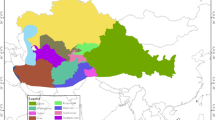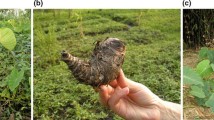Abstract
Little information is available regarding the biodiversity and potential use of jute (Corchorus species) in Ethiopian agriculture. The present study summarizes species’ occurrence, use, geographical distribution, ecology, and ethnobotany of Corchorus species in Ethiopia. An ecogeographical study, conducted in the Amhara, Oromia and Gambella Regional States in 2005 and 2008 resulted in the collection of seven different species with more than 100 accessions. The study revealed low similarity in species composition between the Regional States, indicating that each region has its own unique set of species. Species numbers are higher in the north-eastern and south-western than the central part of the country. C. aestuans L. and C. tridens L. are restricted to humid lowlands of south-western part of Ethiopia, growing at elevations up to 490 m, whereas, C. urticifolius Wight et Arn., C. trilocularis L. and C. schimperi Cufod. were collected only in the north-eastern part of the country with elevation ranges of 1,380–2,130 m. The only species collected at a higher elevation (>2,100 m) was C. schimperi Cufod. Farmers’ perception, indigenous knowledge and folk taxonomy of jute species are better in Gambella than the other studied regions. Although several Corchorus species are reported from Ethiopia, these species are neither cultivated nor popularly used as leafy vegetables. This is mainly due to lack of awareness or knowledge about the species use, and abundant distribution of the species that allows gathering of edible leaves with little expenditure of time, labour and other resources. Our results revealed that some species are threatened, which necessitates highest priority for jute germplasm conservation in the country. In addition, creating public awareness about the use of jute species as a cheap source of leafy vegetable will play an important role to diversify food sources, reduce malnutrition, and contribute to household income generation of the farming community.





Similar content being viewed by others
References
Almekinders C, de Boef W (2000) Encouraging diversity: the conservation and development of plant genetic resources. Intermediate Technology Publications, London, pp 1–362
Alverson WS, Whitlock BA, Nyffeler R, Bayer C, Baum DA (1999) Phylogeny of the core Malvales: evidence from ndhF sequence data. Am J Bot 86:1474–1486
Asfaw Z (1997) Conservation and use of traditional vegetables in Ethiopia. In: Guarino L (ed) Traditional African Vegetables. Promoting the conservation and use of underutilized and neglected crops. Proceedings of the IPGRI international workshop on genetic resources of traditional vegetables in Africa: conservation and use, 29–31 August 1995, ICRAF, Nairobi, Kenya. Institute of Plant Genetics and Crop Plant Research, Gatersleben/International Plant Genetic Resources Institute, Rome, Italy
Awas T, Demissew S, Bekele T (1997) Ethnobotanical study of non-cultivated food plants in Gambella Region, southwestern Ethiopia, In: Fukui K, Eisei K, Masayoshi S (eds) Ethiopia in broader perspective, vol III. Papers of the XIIIth international conference of Ethiopian studies, Kyoto
Balemie K, Kebebew F (2006) Ethnobotanical study of wild edible plants in Derashe and Kucha Districts, South Ethiopia. J Ethnobiol Ethnomed 53:1–9
Basu A, Ghosh M, Mayer R, Powell W, Basak SL, Sen SK (2004) Analysis of genetic diversity in cultivated jute determined by means of SSR markers and AFLP profiling. Crop Sci 44:678–685
Bayer CM, Fay MF, De Bruijn AY, Savolainen V, Morton CM, Kubitzki K, Alverson WS, Chase MW (1999) Support for the expanded family concept of Malvaceae within a recircumscribed order Malvales: a combined analysis of plastid atpB and rbcL DNA sequences. Bot J Linn Soc 129:267–303
Burkill HM (2004) The useful plants of West Tropical Africa, (2nd edn), vol 6, general index. Royal Botanical Gardens, Kew
CSA (1999) Central Statistical Agency, report on the 1998 health and nutrition survey, Addis Ababa, Ethiopia, p 275
CSA (2008) Central Statistical Agency, 2007/2008, agricultural sample survey, report on area and production of crops, volume I. Addis Ababa, Ethiopia, p 128
Dansi A, Adjatin A, Adoukonou-Sagbadja H, Falad’e V, Yedomonhan H, Odou D, Dossou B (2008) Traditional leafy vegetables and their use in the Benin Republic. Genet Resour Crop Evol 55:1239–1256
Edmonds JM (1990) Herbarium survey of African Corchorus L. species. Systematic and ecogeographic studies on crop genepools 4. International Board for Plant Genetic Resources, Rome
GFU (no date). Retrieved on June 2007 from http://www.lc.unsw.edu.au/onlib/ref_elec1.html)
Grubben GJH, Denton OA (2004) Plant Resources of Tropical Africa 2. Vegetables. PROTA Foundation; CTA, Wageningen, p 667
Guarino L (1997) Traditional African vegetables. Promoting the conservation and use of underutilized and neglected crops. In: Guarino L (ed) Proceedings of the IPGRI international workshop on genetic resources of traditional vegetables in Africa: conservation and use, 29–31 August 1995, ICRAF-HQ, Nairobi, Kenya. Institute of Plant Genetics and Crop Plant Research, Gatersleben/International Plant Genetic Resources Institute, Rome, Italy
Hammer K (2003) Resolving the challenges posed by agrobiodiversity and plant genetic resources—an attempt, Beiheft Nr. 76. Journal of Agriculture and Rural Development in the Tropics and Subtropics, Kassel University Press
Hammer K, Lehmann CO, Perrino P (1988) A check-list of the Libyan cultivated plants including an inventory of the germplasm collected in the years 1981, 1982 and 1983. Kulturpflanze 36:475–527
Heywood VH (1993) Flowering plants of the world. Oxford University Press, New York
Heywood VH, Brummitt RK, Culham A, Seberg O (2007) Flowering plant families of the world. Royal Botanical Gardens, Kew
Hossain MB, Haque S, Khan H (2002) DNA fingerprinting of jute germplasm by RAPD. J Biochem Mol Biol 35:414–419
IBCR (2001) Twenty-five years of biodiversity conservation and utilization and future plan of action. Institute of Biodiversity Conservation and Research, Artistic Printing Enterprise, Addis Ababa, Ethiopia
Innami S, Tabata K, Shimizu J, Kusunoki K, Ishida H, Matsuguma M, Wada M, Sugiyama N, Kondo M (1998) Dried green leaf powders of Jew’s mellow (Corchorus), persimmon (Diospyros kaki) and sweet potato (Ipomoea batatas Poir.) lower hepatic cholesterol concentration and increase fecal bile acid excretion in rats fed a cholesterol-free diet. Plant Foods Hum Nutr 52:55–65
Kinabo J, Mnkeni AP, Nyaruhucha CNM, Msuya J, Haug A, Ishengoma J (2006) Feeding frequency and nutrient content of foods commonly consumed in the Iringa and Morogoro regions in Tanzania. Int J Food Sci Nutr 57:9–17
Krebs G (2001) Tiliaceae. In: Hanelt P, Institute of Plant Genetics and Crop Plant Research (eds) Mansfeld’s encyclopedia of agricultural and horticultural crops. Volume 3. Angiospermae—Dicotyledones: Malpighiaceae—Oleaceae. Springer, Berlin, pp 1560–1567
Martin FW, Ruberte RM (1975) Edible leaves of the tropics. Mayaguez Institute of Tropical Agriculture, Puerto Rico
Mary AO (2007) Seed production and support systems for African leafy vegetables in three communities in Western Kenya. Afric J Food Agric Nutrit Develop 7(3)
Maundu PM, Ngugi GW, Kabuyl CHS (1999) Traditional Food Plants of Kenya. National Museums of Kenya, Nairobi, Kenya
Oboh G (2006) Tropical green leafy vegetables prevent garlic-induced hepatotoxicity in the rat. J Med Food 9:545–551
Orech FO, Christensen DL, Larsen T, Fris H, Aagaard-Hansen J, Estambale A (2007) Mineral content of traditional leafy vegetables from western Kenya. Int J Food Sci Nutr 58:595–602
Pistrick K, Loumerem M, Haddad M (1994) Field studies of plant genetic resources in South Tunisia. FAO/IPGRI. Plant Genet Resour Newsl 98:13–17
Qi J, Zhou D, Wu W, Lin L, Wu J, Fang P (2003) Application of ISSR technology in genetic diversity detection of jute. Ying Yong Sheng Tai Xue Bao 14:1473–1477
Roy A, Bandyopadhyay A, Mahaptra AK, Ghosh SK, Singh NK, Bansal KC, Koundal KR, Mohapatra T (2006) Evaluation of genetic diversity in jute (Corchorus species) using STMS, ISSR and RAPD markers. Plant Breed 125:292–297
Scotland RW, Wortley AH (2003) How many species of seed plants? Taxon 52:101–104
Steyn NP, Olivier J, Winter P, Burger S, Nesamvuni S (2001) A survey of wild, green, leafy vegetables and their potential in combating micronutrient deficiencies in rural populations. S Afr J Sci 97:276–279
Tadesse M (1987) Corchorus species herbarium voucher specimen no. 6729. National Herbarium, Addis Ababa University (ETH), Ethiopia
Terra GJ (1967) Tropical vegetables. Communication 54. RTI, Amsterdam
The Angiosperm Phylogeny Group (APG) (1998) An ordinal classification for the families of flowering plants. Ann Mo Bot Gard 85:531–553
Thompson JL, Gebauer J, Hammer K, Buerkert A (2009) The structure of urban and peri-urban gardens in Khartoum, Sudan. Genet Resour Crop Evol (in press)
Vollesen K, Demissew S (1995) Corchorus. In: Edwards S, Tadesse M, Hedberg I (eds) Flora of Ethiopia and Eritrea. Volume 2, part 2. Canellaceae to Euphorbiaceae. The National Herbarium, Addis Ababa University and Department of Systematic Botany, Uppsala University, Addis Ababa and Uppsala, pp 154–158
Whitlock BA, Karol KG, Alverson WS (2003) Chloroplast DNA sequences confirm the placement of the enigmatic Oceanopapaver within Corchorus (Grewioideae: Malvaceae s.l., formerly Tiliaceae). Int J Plant Sci 164:35–41
Wild H (1984) Flora of Southern Africa 21 (1: Tiliaceae). Botanical Research Institute, Department of Agriculture, Pretoria
Acknowledgments
The authors are very grateful to the farmers of Ethiopia, who generously cooperated and imparted during the collection program. Special thanks to Tesfaye Awas for his invaluable discussion and contribution of C. capsularis germplasm collected in Gambella Regional State. The authors are also indebted to Abyot Gashaw and Atalay Mekonnen for assisting the first author in the 2008 field work. Staffs members of the Gambella Agricultural Research Institute and the National Herbarium, Biology Department, Addis Ababa University are acknowledged for the kind cooperation in the process of germplasm collection and voucher specimen preparation, respectively. Ecogeographical survey and germplasm collection in 2005 was supported by the research grant from Hawassa University, Ethiopia. This study was supported by the German Academic Exchange Service (DAAD).
Author information
Authors and Affiliations
Corresponding author
Rights and permissions
About this article
Cite this article
Benor, S., Blattner, F.R., Demissew, S. et al. Collection and ethnobotanical investigation of Corchorus species in Ethiopia: potential leafy vegetables for dry regions. Genet Resour Crop Evol 57, 293–306 (2010). https://doi.org/10.1007/s10722-009-9470-y
Received:
Accepted:
Published:
Issue Date:
DOI: https://doi.org/10.1007/s10722-009-9470-y




